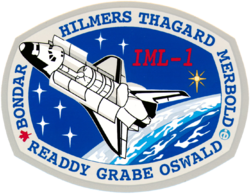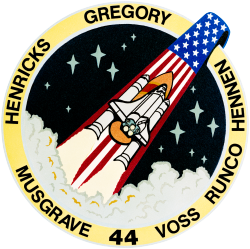STS-44
| Missionsemblem | |||||
|---|---|---|---|---|---|
 | |||||
| Missionsstatistik | |||||
| Missionsnavn: | STS-44 | ||||
| Rumagentur: | NASA | ||||
| Rumfærge: | Atlantis (10) | ||||
| Antal besætningsmedlemmer: | 6 | ||||
| Affyringsrampe: | LC-39A (KSC) | ||||
| Opsendelse: | 24. november 1991 | ||||
| Landing: | 1. december 1991 | ||||
| Landet på: | Edwards Air Force Base | ||||
| Varighed: | 6 døgn og 22 timer | ||||
| Foto af besætningen | |||||
 | |||||
| Navigation | |||||
| |||||
STS-44 (Space Transportation System-44) var rumfærgen Atlantis 10. rumfærge-mission. Den blev opsendt d. 24. november 1991 og vendte tilbage den 1. december 1991.
Missionen medbragte delvis klassificeret militær last for Forsvarsministeriet (USA) (DoD).
Hovedartikler:
Besætning

 Frederick Gregory (kaptajn)
Frederick Gregory (kaptajn)
 Terence Henricks (pilot)
Terence Henricks (pilot)
 Story Musgrave (1. missionsspecialist)
Story Musgrave (1. missionsspecialist)
 Mario Runco (2. missionsspecialist)
Mario Runco (2. missionsspecialist)
 James Voss (3. missionsspecialist)
James Voss (3. missionsspecialist)
 Thomas Hennen (nyttelast-specialist)
Thomas Hennen (nyttelast-specialist)
Missionen
Missionen medbragte følgende nyttelast:
- Hemmelig militær last
- Defense Support Program (DSP)
- Satellite and attached Inertial Upper Stage (IUS)
- Interim Operational Contamination Monitor(IOCM)
- Terra Scout; Military Man in Space (M88-1)
- Air Force Maui Optical System (AMOS)
- Cosmic Radiation Effects and Activation Monitor (CREAM)
- Shuttle Activation Monitor (SAM)
- Radiation Monitoring Equipment III (RME III)
- Visual Function Tester-1 (VFT-1)
- Ultraviolet Plume Instrument (UVPI)
- Bioreactor Flow and Particle Trajectory experiment
- Extended Duration Orbiter Medical Project
Eksterne henvisninger
- STS-44 NASA (engelsk)
- STS-44 Arkiveret 27. maj 2010 hos Wayback Machine NASA KSC (engelsk)
Medier brugt på denne side
Forfatter/Opretter: Kwamikagami, Licens: CC BY-SA 4.0
symbol of Mars. 16 × 16 pixel nominal dimensions, lines 2 pixel thick, square caps. Colour 75% blue: red=0 green=0 blue=191 (#0000BF).
The STS-44 crew portrait includes 6 astronauts. Pictured seated, from left to right, are Terence T. Hendricks, pilot; Frederick D. Gregory, commander; and F. Story Musgrave, mission specialist. Standing on the back row (left to right) are James S. Voss, mission specialist; Thomas J. Hennen, payload specialist; and Mario Runco, Jr., mission specialist. The 6 crew members launched aboard the Space Shuttle Atlantis on November 24, 1991 at 6:44:00 pm (EST). Dedicated to the Department of Defense (DOD), the mission's primary unclassified payload was the Defense Support Program (DSP) satellite and attached Inertial Upper Stage (IUS).
STS-42 Mission Insignia
Space Shuttle Atlantis takes flight on its STS-27 mission on December 2, 1988, 9:30 a.m. EST, utilizing 375,000 pounds thrust produced by its three main engines. The STS-27 was the third classified mission dedicated to the Department of Defense (DoD). After completion of mission, Orbiter Atlantis landed December 6, 1988, 3:36 p.m. PST at Edwards Air Force Base, California.
Image of powerful Typhoon Yuri in N. Pacific (E. of Philippine Islands) taken by STS-44 crew during 10th flight of space shuttle Atlantis on mil. mission (24th Nov-1st Dec.).
STS-44 Mission Insignia
Forfatter/Opretter: Kwamikagami, Licens: CC BY-SA 4.0
symbol of Mars. 16 × 16 pixel nominal dimensions, lines 2 pixel thick, square caps. Colour 75% blue: red=0 green=0 blue=191 (#0000BF).
STS-44 Defense Support Program (DSP) / Inertial Upper Stage (IUS) spacecraft, with forward airborne support equipment (ASE) payload retention latch actuator released (foreground), is raised to a 29 degree predeployment position by the ASE aft frame tilt actuator (AFTA) table in the payload bay (PLB) of Atlantis, Orbiter Vehicle (OV) 104. Underneath the DSP / IUS combination, the umbilical boom is connected to the IUS. DSP components include Infrared (IR) sensor (top), AR I, SHF Antenna, EHF Antenna, Link 2 High-Gain Antenna, star sensor, and stowed solar paddles (box-like structure around the base). The Earth's limb and the blackness of space create the backdrop for this deployment scene.
STS-48 Mission Insignia
- Designed by the astronaut crewmembers, the STS 48 patch represents the Space Shuttle Orbiter Discovery in orbit about the Earth after deploying the Upper Atmospheric Research Satellite (UARS) depicted in block letter style. The stars are those in the Northern Hemisphere as seen in the fall and winter when UARS will begin its study of Earth's atmosphere. The color bands on Earth's horizon, extending up to the UARS spacecraft, depict the study of Earth's atmosphere. The triangular shape represents the relationship among the three atmospheric processes that determine upper atmospheric structure and behavior: chemistry, dynamics and energy. In the words of the crewmembers, This continuous process brings life to our planet and makes our planet unique in the solar system."











